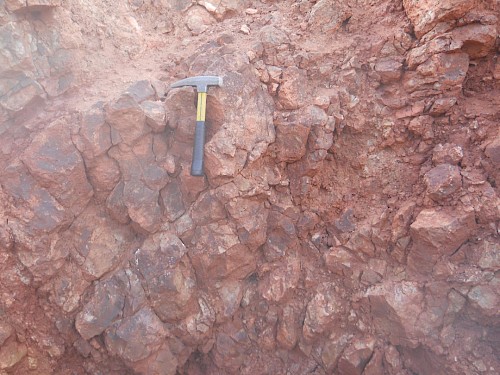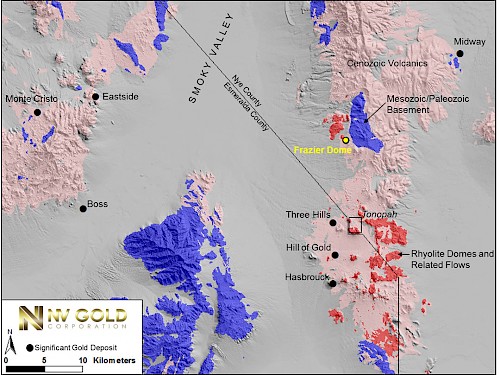The Frazier Dome project consists of mining claims 13 km north of the Tonopah mining district. The project contains a low-sulfidation, volcanic-hosted epithermal gold system with high-grade mineralization in three settings. Gold occurs in silicified breccias and veins adjacent to and likely genetically-related to a Middle Miocene felsic dome (Company samples to 6.1 g/t Au, historic samples to 14.7 g/t Au). High-grade gold also occurs in north-northwest-trending quartz vein stockworks (Company samples to 11.2 g/t Au) within the volcanic rocks farther from the dome and along the contact between the volcanics and underlying pre-Cenozoic basement (historic drill hole with 7.5 g/t over 3 m at 58 m, including 10.39 g/t over 1.5 m). The project also contains low-grade gold mineralization in silicified volcanics lacking veins (Company samples to 0.50 g/t Au; historic drilling of 0.85 g/t over 15 m). Mineralization and alteration project under thin post-mineral volcanic and alluvial cover. Veins have been traced for as much as 370 m before projecting under the cover.
The Tonopah district contains two styles of volcanic-hosted epithermal gold mineralization: high-grade, intermediate-sulfidation Ag-rich veins which historically produced 174 million ounces (Moz) Ag and 1.9 Moz Au, and a younger, low-sulfidation, gold-rich mineralization event related to intrusive rhyolite domes which has been the focus of modern exploration (e.g., Hasbrouck deposit). The Frazier Dome mineral system is similar to the later mineralization in the Tonopah district and to Columbus Gold’s Eastside Project 32 km to the west across Smoky Valley, where gold mineralization is associated with rhyolite domes.
Historic drilling between 1980 and 1991 intersected significant gold mineralization (Table 1) but was shallow (< 150 m) and failed to test all areas of outcropping gold or for mineralization beneath the cover. Based on the Company’s preliminary work, the principal exploration target is gold mineralization adjacent to the intrusive dome, especially at the basement contact, known to be mineralized farther from the dome and to be a setting conducive to the development of high-grade epithermal mineralization elsewhere in Nevada.
Table 1.
Mineralized Intersections in Historic Drill Holes*
| Hole | From ft | To ft | Interval ft | Au ppm (g/t) | From m | To m | Interval m |
|---|---|---|---|---|---|---|---|
| 80-2 (55 m, vertical) | 65 | 95 | 30 | 0.400 | 19.8 | 29.0 | 9.1 |
| 80-3 (67 m, vertical) | 190 | 200 | 10 | 7.457 | 57.9 | 61.0 | 3.0 |
| including | 190 | 195 | 5 | 10.388 | 57.9 | 59.4 | 1.5 |
| 82-3 (101 m, vertical) | 35 | 40 | 5 | 0.617 | 10.7 | 12.2 | 1.5 |
| 82-4 (104 m, vertical) | 240 | 255 | 15 | 0.240 | 73.2 | 77.7 | 4.5 |
| 91-1 (152 m, 300/-63 | 205 | 230 | 25 | 2.367 | 62.5 | 70.1 | 7.6 |
| 91-2 (122 m, 325/-60) | 20 | 70 | 50 | 0.852 | 6.1 | 21.3 | 15.2 |
| FW1 (152 m, vertical) | 220 | 250 | 30 | 0.179 | 67.1 | 76.2 | 9.1 |
| FW3 (128 m, 90/-45) | 120 | 130 | 10 | 0.161 | 36.6 | 39.6 | 3.0 |
| 255 | 265 | 10 | 0.217 | 77.7 | 80.8 | 3.1 | |
| 315 | 320 | 5 | 0.349 | 96.0 | 97.5 | 1.5 | |
| 345 | 355 | 10 | 0.181 | 105.2 | 108.2 | 3.0 | |
| 360 | 375 | 15 | 0.266 | 109.7 | 114.3 | 4.6 | |
| 400 | 410 | 10 | 0.338 | 121.9 | 125.0 | 3.1 | |
| FW4 (91 m, 270/-45) | 0 | 25 | 25 | 0.540 | 0 | 7.6 | 7.6 |
| FW5 (104 m, 90/-60) | 0 | 10 | 10 | 0.301 | 0 | 3.0 | 3.0 |
| 120 | 125 | 5 | 0.300 | 36.6 | 38.1 | 1.5 | |
| 285 | 295 | 10 | 0.297 | 86.9 | 89.9 | 3.0 |
*0.100 g/t cutoff

Hematitic silicified breccia adjacent to rhyolite dome
NV Gold sample JM-FW8 (6.1 g/t Au, 22 g/t Ag over 3 m)

